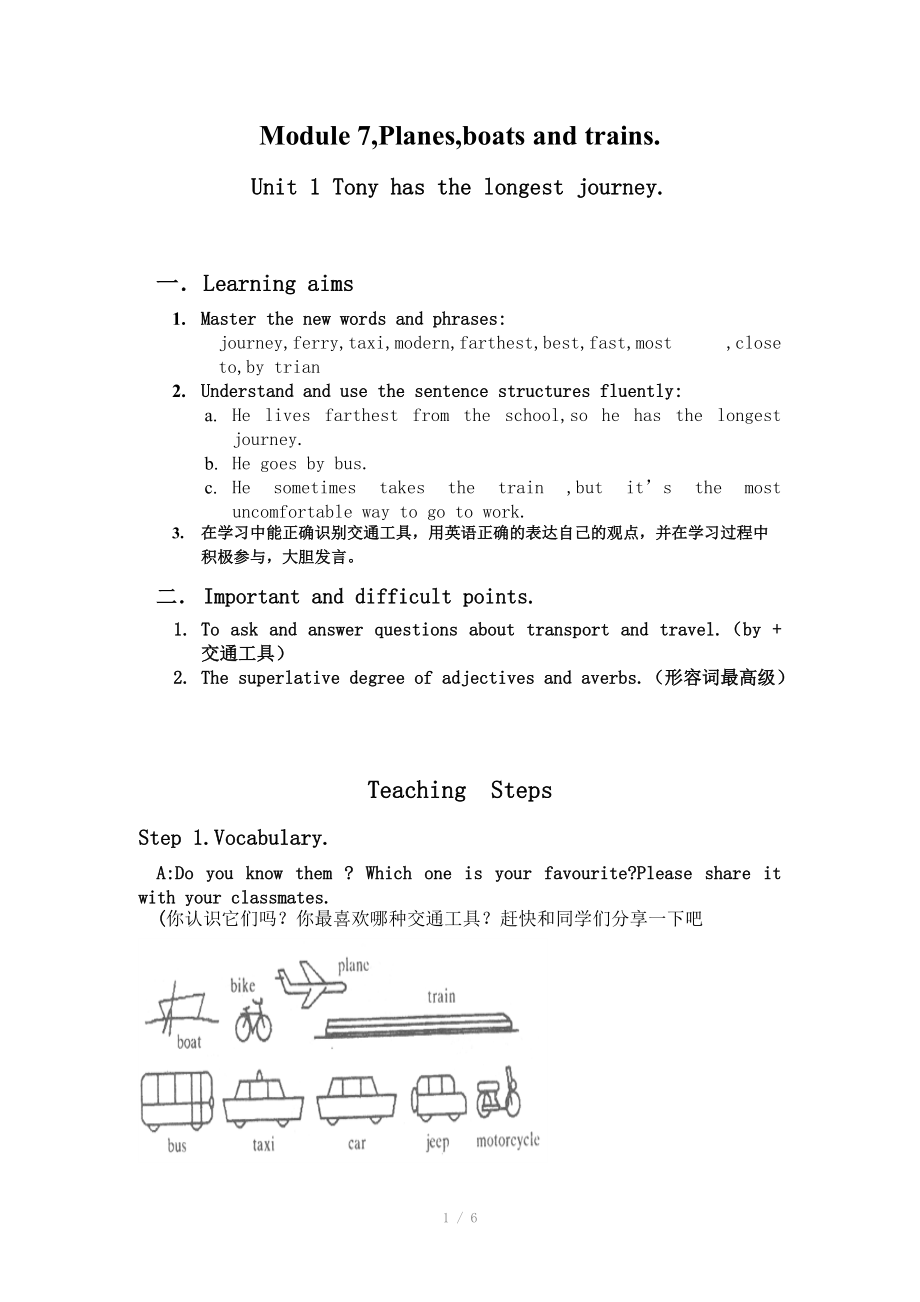《英語七年級下外研版Module 7 Unit 1 Tony has the longest journey 教案》由會員分享���,可在線閱讀�,更多相關(guān)《英語七年級下外研版Module 7 Unit 1 Tony has the longest journey 教案(6頁珍藏版)》請在裝配圖網(wǎng)上搜索���。
1���、
Module 7,Planes,boats and trains.
Unit 1 Tony has the longest journey.
一. Learning aims
1. Master the new words and phrases:
journey,ferry,taxi,modern,farthest,best,fast,most ,close to,by trian
2. Understand and use the sentence structures fluently:
a. He lives farthest from the s
2、chool,so he has the longest journey.
b. He goes by bus.
c. He sometimes takes the train ,but it’s the most uncomfortable way to go to work.
3. 在學習中能正確識別交通工具�����,用英語正確的表達自己的觀點�����,并在學習過程中積極參與���,大膽發(fā)言�����。
二. Important and difficult points.
1. To ask and answer questions about transport and travel.(by +交通工具)
2
3��、. The superlative degree of adjectives and averbs.(形容詞最高級)
Teaching Steps
Step 1.Vocabulary.
A:Do you know them ? Which one is your favourite?Please share it with your classmates.
(你認識它們嗎���?你最喜歡哪種交通工具����?趕快和同學們分享一下吧
P.S.如果你還知道其他的交通工具���,請把它們的美姿和名字展示在這里。
2 / 6
B:What ca
4�、n you see in these pictures ?Please write down their names in English.
(從圖片中你看到了什么?請寫出你看到的交通工具的英文名字��。)
C:Phrases (短語翻譯)(by +交通工具)
同學們��,你知道怎樣騎乘各種各樣的交通工具嗎����?試一試吧。
1.騎自行車 2. 乘公共汽車
3.乘地鐵 4
5��、.乘火車
5.乘飛機 6.乘出租車
Step 2.Listen and match.(把聽到的交通工具與其相對應(yīng)的修飾性形容詞相連).
A. B.
train modern
plane crowded
ferry comfortable
bus larg
6����、e
subway famous
taxi cheap
Step 3.Listen,ask and answer.(聽課文錄音,回答下列問題)
How many people are Betty and her mum talking about ?
And who are they ?
――How does …… get to school ?
――By……
Step 4.Say who. (讀課文�����,回答下列問題).
For example:
7、
——Who lives farthest from the school ?
——Tony lives farthest from the school.
1.Who lives closest to the school ?
2.Who has the longest journey ?
3.Who has the fastest journey ?
4.Who has the most dangerous journey ?
5.Who has the most expensive journey ?
6.Who has t
8����、he most uncomfortable journey ?
Step 5.Language Points.
1. 形容詞、副詞的最高級���。
當我們需要對三個或三個以上的人或事物進行比較��,來表達最高�����、最遠���、最快等意義的時候,我們可以用形容詞和副詞的最高級形式來表達����。
其變化規(guī)則如下:
構(gòu)成方法
原形
最高級
一般在詞尾加
tall
small
tallest
smallest
以e結(jié)尾的,直接加
nice
nicest
fine
以重讀閉音節(jié)結(jié)尾的�,如末尾只有一個輔音字母,應(yīng)先 該字母
9、��,再加est
big
hot
fat
biggest
以“輔音字母+y”結(jié)尾的��,先把 y 變成 i ��,再加est
busy
easy
多音節(jié)和部分雙音節(jié)詞��,在其前加most
dangerous
careful
2.by + 交通工具 表示“乘….坐…”�,注意表示交通工具的名詞前不能有冠詞。
如:by bus , by plane.
Step 6. Exercises.
用所給詞的適當形式填空
10���、
1. Which is (small), the sun, the moon or the earth?
2. Of all the students in our group who lives (far)?
3. Shanghai is the (big) city in China.
4. Oct.1 was one of (exciting) days in 2009. It’s the 60th birthday of our motherland(祖國).
單項選擇
11、
1. I think Yao ming will be___new star in NBA.
A.hot B.hotter C. hottest D.the hottest
2.—Which is ___season in Beijing?
—I think it’s autumn.
A.good B.better C.best D.the best
3.I often go to school ___ .
A.by a bike B.on foot C.by bus
4. —How do you get to beijing?
—___.
A.On plane B.By plane C.In plane
5.He usually come home by bike,but sometimes he comes ___.
A.by foot B.on foot C.by the feet
Step 6. Homework
Workbook page112 activity 1.
希望對大家有所幫助��,多謝您的瀏覽��!
 英語七年級下外研版Module 7 Unit 1 Tony has the longest journey 教案
英語七年級下外研版Module 7 Unit 1 Tony has the longest journey 教案

